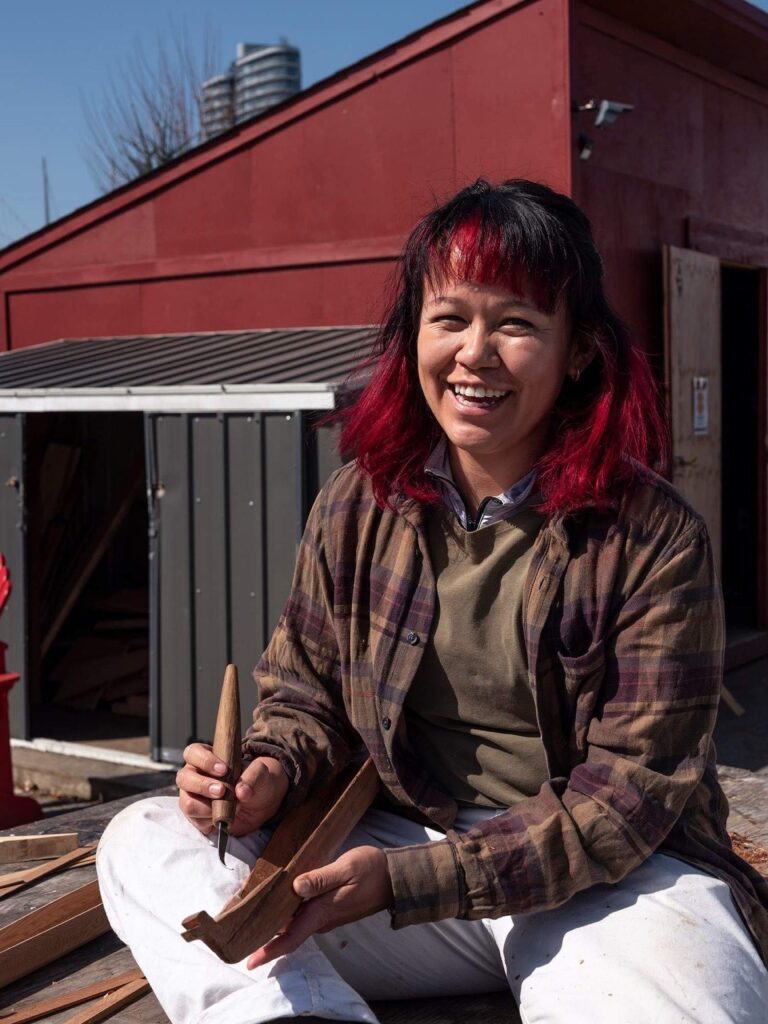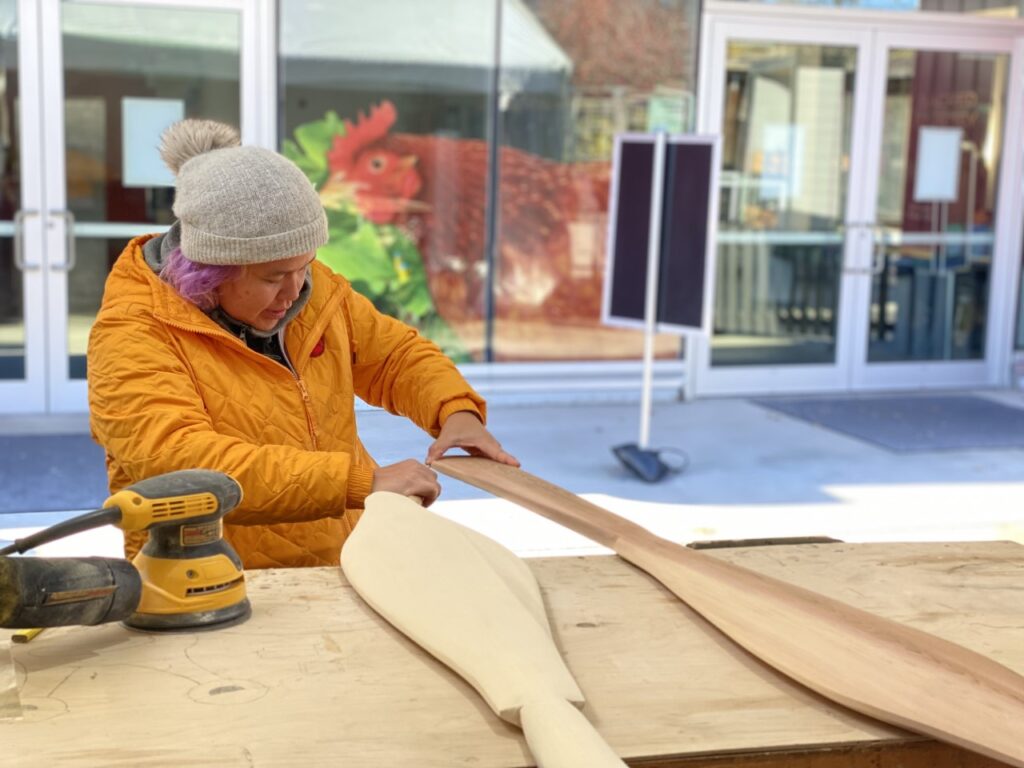

Twenty-six years ago, Joanne Stone-Campbell of Squamish Nation participated in her first Canoe Journey.
A member of the ground crew, she helped with the hard work of transporting gear to each destination, setting up and breaking camp, and preparing meals for the paddlers.
At night, everyone shared a meal together. During a talking circle, they connected through conversations about their opinions, feelings and experiences.
"For many, it was their first time sharing their story," she recalls.
On the last stretch of the journey, as all the Canoe Families entered the harbour of Victoria, the paddlers invited Joanne onboard to sit with them. "I felt like a princess," she laughs, "waving to everyone as we approached."
She'd never seen anything as beautiful as all the Indigenous Canoe Families onshore at the welcoming ceremony, sharing their songs, dances and language.
"I didn't grow up with that. We weren't allowed to do any of that. So, it was huge to witness the celebration of it."
Today, Joanne manages Indigenous partnerships for Vancity and helped coordinate the month-long Paddle Carving demonstration at Science World alongside the Sacred Journey exhibition.
"Indigenous kids can enter Science World and see these artists, in real time, creating new pieces of their beautiful culture. They'll connect to it, one-on-one and hands-on. And non-Indigenous people will know we're still here. We didn't die. We're alive, we're well, we're smart. We have lots of passion and excitement. And we have important art to share."
Carving Out New Space

Twelve years ago, Lydia Brown of Snuneymuxw Nation participated in her first Canoe Journey.
"I was nervous to apply, because I'd never paddled before. But my sister said, 'This is your chance!'"
The twists and turns of the coastline from Vancouver Island to Washington State taught her how to relax. "You don't know what's going to happen moment to moment, and you learn to be okay with that."
The adventure ignited a passion for canoe culture and carving.
Her first memory of carving is watching her older teenage cousin go door to door, selling his wooden pieces: otters holding urchins, killer whales and salmon. They filled the walls of her childhood home. "My parents really supported him. On the reserve, it's just a common thing to share your wealth."
Lydia says her family have always recognized that, in order to learn, it was important to have time and space for hands-on activities. "I was very fortunate to grow up and feel that support in my community to pursue the arts."
She received a Bachelor of Fine Arts from Emily Carr University of Art and Design. There, she learned that there wasn’t a word for "art" in Indigenous languages. It was just a way of living, akin to the way her father is a fisherman and her mother cooks huge meals that feed many mouths.
"My grandparents, parents, aunties, uncles, siblings and cousins all had an art, whether it was hunting, weaving, photography or beading. It's all craft, labour and patience for the community."
At first, Lydia struggled to find a carving mentor and is grateful for her current apprenticeship at Canoe Cultures and artist-in-residency at Skwachàys Lodge.
And now, with Gerry Sheena at Science World during this one-month paddle-carving demonstration, she receives one-on-one guidance on a style of paddle that is brand new to her.

"This shape," she says, holding up the curved paddle of yellow cedar, "is a shape that Gerry taught me."
Carving Through Time
Last year, Gerry Sheena of Interior Salish Nation participated in his first Canoe Journey.
For a long time, he'd worked behind the scenes with his then-partner and mother of his children Emanuela Sheena, who leads the Canoe Club at Collingwood Neighbourhood house.
He supported the club by helping to fundraise for canoes, draw designs on paddles for kids to paint, and carve paddles as after-journey gifts.

After they separated, Emanuela was diagnosed with ALS. Despite her children's protests, she still wanted to participate in the Canoe Journey.
"So," Gerry said, "I decided to go with her to help."
He's glad he did. "It was different to see it with my own eyes. That excitement, the teamwork, the patience. It definitely made me wish I could have done it when I was young."
When he was young, Gerry tagged along with his older brother to native art galleries in Vancouver. "I'd see the masks and the poles, and I was in awe. I said to myself, 'I wish I could do that.'"
It wasn't until, as a young adult, he met Opie Oppenheim, a professional artist from his community, that he saw what was possible. "He had a huge gallery and was successful. He told me I could make it as an artist if I worked hard."
Gerry enrolled in art classes and Emily Carr and Langara, but struggled to find mentors who knew the native form lines. Finally, he sought guidance from his sibling, who carved designs into wood plaques.
"I said, 'Teach me how to carve, brother!' And he said, 'Get some tools and just do it.'"
And though Gerry's first attempt was "a disaster, with a giant stump of cedar and the wrong chisels," he persevered.
Today, his beautiful totem poles, paddles and masks often feature salmon, "to acknowledge their plight."
He remembers as a child witnessing tens of million salmon return to his local river. By the time his own kids were born, the number had decreased to two million. Last year, just hundreds of thousands.
He cites humans--salmon farms, overfishing and rising ocean temperatures--as culprits in the animal's decline. For the fish, he signs his art "S.O.S. 'Save Our Salmon'."
"Above and beyond us humans, it's the bears, eagles, ravens, wolves, sea otters, killer whales and the forests who need salmon," Gerry says.
"We come second, but we seem to take a lot more than our share."
Witness more art from Indigenous creators at Science World.
Science World is pleased to partner with the Skwachàys Lodge Artist in Residence Program to display the artwork of talented artists. On display now in our atrium.
From Vancity: Vancity is a values-based financial co-operative founded in 1946 with the purpose of providing financial services to every individual regardless of their background. Reconciliation is one of Vancity’s core values. This means we use the tools of finance to address systemic barriers and advance economic Reconciliation, knowing that this urgent and long-term work is never complete. Our commitment to the Progressive Aboriginal Relations (PAR) certification program marks the latest phase in our ongoing journey. This builds on steps we've taken, such as being a founding partner of Reconciliation Canada, adopting the call to action for businesses from the Truth and Reconciliation Commission, and adopting the UN Declaration of the rights of Indigenous Peoples. Vancity has offices and 54 branches located in Metro Vancouver, the Fraser Valley, Victoria, Squamish and Alert Bay, within the territories of the Coast Salish and Kwakwaka’wakw people.
